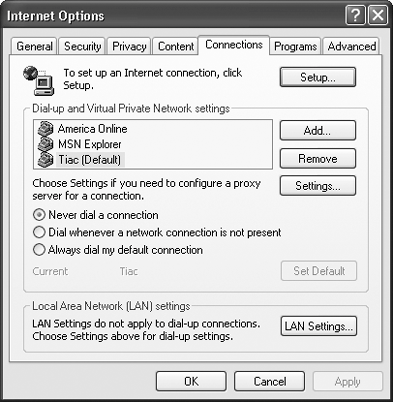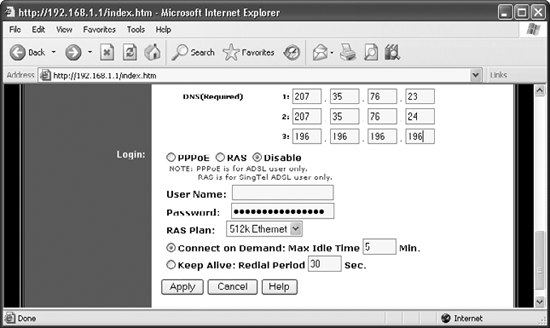BROADBAND: CABLE AND DSL CONNECTIONS
SLOW-AS-MOLASSES CABLE MODEMThe Annoyance:When I installed my cable modem, it was faster than greased lightning. Now it's slow as molasses. It's really slow when it rains. Am I crazy, or can there be some cause and effect here? Figure 2-4. If you have an always-on broadband service, tell Windows to nix the dial-up option. The Fix:It sounds like your outside cable connection is loose or in some way exposed to the elements. That's why, when it rains, your Internet speed heads south. Get your cable company to check the cable connection to your house, as well as the connection from the pole. If no problems are found, have them check for a cable splitter installed in your house. Splitters are sometimes used to separate data and video connections, and if there's a problem with your splitter, you may have problems with your Internet connection. FIX THIS SLOW-AS-MOLASSES CABLE MODEM, TAKE 2The Annoyance:I followed your advice and had the cable company check my connections. The connections were fine, but the connection's still slow as a dog. I forgot to mention that I use a router at home, which my cable company set up for me when they installed my cable modem. Is the router the problem?
The Fix:Ah, I see the solution. When your cable company installed your router, they set it to use specific DNS (Domain Name Service) addressesand chances are they've since changed them without telling you. While you can still make an Internet connection, it's painfully slow because you're going to DNS servers that are outside your cable network, which slows things down. How you change DNS settings varies from router to router, but here's how you'd do it on a Linksys home router:
If your ISP didn't set up your router and enter DNS addresses (or have you enter them), don't go through this process, because it won't help. Your problem isn't related to DNS. Try plugging your cable modem directly into your PC's Ethernet port, bypassing the router. If that solves the problem, you have trouble with your router, and you may need a new one.
REVIVE YOUR DSL CONNECTIONThe Annoyance:For reasons I can't fathom, my DSL connection is suddenly dead. No matter what I do, I can't get onto the Internet. I've used every troubleshooting tool known to bipeds; I've reset my TCP/IP setting, turned off my firewall and pop-up blocker, and more, but still, no Internet. The Fix:Often the fix is a simple finger flick away. (No, not that finger!) Simply turn off your DSL modem for five minutes, and then turn it back on again. It's amazing how frequently that will solve your problem. The solution works with cable modems as well. Of course, this doesn't always work. Sometimes you can revive the connection by reloading your DSL dialer application, or by rebooting your PC and then reloading the dialer app. Look, too, for sources of electromagnetic radiation that might be annoying your modem (such as 900-MHz to 2.4-GHz portable phones, security alarms, or digital phone systems), or even a kink in the cable. INTERNAL WIRING SCAMThe Annoyance:My DSL connection drops intermittently and slows down without warning. The phone company claims that the problem is my house's "internal wiring" and wants to charge me big bucks to check it out. Are they scamming me? The Fix:In the Byzantine economics of DSL service, if a tech guy or gal steps into your house to troubleshoot a problem, the high-priced meter starts ticking. But if the techie finds the problem outside the house, you get the problem fixed for free. So tell your ISP to send out a techie to run a line test from the telephone pole to your house. Next, have him check the configuration of that gray phone box on the outside of your house. Many problems may lurk here. If neither is the source of your problem, and the tech has to check your house's internal wiring, hold onto your wallet. It can easily cost $80 per hour, which sometimes is charged in 15-minute increments of $20. But the costs can go way beyond thatsome ISPs will also charge you a "dispatch fee," which can run to over $200. Note: If you need your home's internal wiring checked, you don't have to turn to your ISP or Baby Bell. Third-party companies can do the job as well, and often for less money.
WHY DOES DSL HATE MY ROUTER?The Annoyance:I can't get my DSL connection to work with my home router. The router maker blames my ISP, and my ISP, of course, blames the router vendor. Which of these turkeys should I baste? The Fix:The most common cause of DSL/router woes is simple to fix: you haven't properly enabled PPPoE on your router, or maybe you haven't enabled it at all. Most DSL connections require this protocol. How you configure it varies by router, but here's how to do it with a Linksys router:
DOES COMCAST CHARGE EXTRA FOR HOME NETWORKING?The Annoyance:I have a Comcast Internet cable connection, and I want to install a home network so that, among other things, several PCs can share the line. But I just checked its web site (http://homenetworking.comcast.net), and bless Comcast's greedy little heart, it tries to sell me a home networking package that'll cost me a whopping $149 for installation, plus $180 or $5 a month rental for a home router that I can buy for less than $50. Worse, it says I can only have five PCs on the network, but I have six and plan to buy two more. What is this, the Soviet Union? Can Comcast force me to pay for this service? Network free or die! The Fix:Comcast's home networking site implies that you must buy a special package if you want to set up a home network to share your cable connection. But if you look elsewhere on the general Comcast site, the company implies that you can set up a home network and share the line without charge. In general, the Comcast site is fairly unclear and unhelpful when it comes to home networking. For example, one page notes that if you want to, you "may order additional network addresses in order to connect several computers to the service through one cable modem." Of course, when you set up a home network, you don't need additional network addresses, because your home router handles the necessary network addresses. I tried clearing up the matter with Comcast, but the company said via email that "we will need to decline" to provide the information I requested. Ah, cable company customer service. Can't beat it. The upshot? I know many people, including myself, who use Comcast's high-speed Internet service with a home network, and none of us has paid Comcast a dime for sharing the line with two or more computers. Based on our tests, it appears that Comcast doesn't really carewe all easily set up home networks, sharing the lines with several PCs, and no one at Comcast griped. If you're still worried about your broadband ISP charging you extra for a home network, you can "hide" the router from your ISP. When you connect a router to a cable modem, your ISP may require you to supply the router's MAC address in order to give it Internet access. The MAC address is a number that uniquely identifies routers, network cards, and similar communications hardware. When you call in with your router's MAC address, the ISP will naturally know you're sharing the line with other computers. If you're paranoid about your broadband ISP finding out, Linksys and other routers let you clone your PC's MAC address and use that for the router. You won't have to call your ISP with the new MAC address, and to the ISP, it'll look like your original PCnot a routeris connected to the cable modem. Tip: Sharing your high-speed Internet connection with other PCs in your home is fine, but sharing it with a neighbor (say, via a wireless WiFi connection) is generally considered verboten. The issue surfaced as far back as 2001, when a spokesperson for AT&T Broadband told the San Francisco Chronicle, "We view it the same way as cable theft... and that's against a variety of state and federal laws." The spokesman went on to say that AT&T Broadband conducted "flyovers" in selected areas, looking for unauthorized "leakage" of cable and broadband signals, and then disconnected any customers responsible for the leakages.Comcast's service agreement notes that "The Service and the Comcast Equipment shall be used only by you and by members of your immediate household living with you at the same address," which certainly seems to rule out sharing Internet access with neighbors. To clone a MAC address on a Linksys router, go to http://192.168.1.1 and log into the Linksys administrator's setup screen, leaving the username blank and entering admin (or whatever you've changed the default to) as the password. Select Advanced COUNTRY BOY HAS DSL PROBLEMSThe Annoyance:I live on the edge of a suburb and recently subscribed to DSL. The DSL company said I'd get a 1.5-Mbps connection, but my real-life connection speed isn't a whole lot faster than it was with my old dial-up modem. I've spent four lifetimes on the phone with tech support, and they know even less about DSL than I dowhich is approximately zero. Is there a way to fix the problem? The Fix:What DSL providers don't always tell you is that you must be within a certain distance of the "central office" (the phone company's local switching station) to get top speeds. As a general rule, you should be within 14,000 feet (closer is better), or you won't get a solid, speedy connection. Also, remember that the distance is not as the crow flies, but rather as the phone line twists and turns its way from the central office to you. In this case, it sounds like you're past the point of reasonable performance. There's not much you can do except complain until they put a switch nearer to your home (don't hold your breath) or cancel your service. If you can get cable service, make the switch nowcable doesn't suffer from the distance limitations.
NEW CONNECTION WIZARD WOESThe Annoyance:I want to create a new DSL connection using XP's New Connection Wizard (via the Network Connections control panel), but the "Connect using a broadband connection that requires a user name and password" option is grayed out. Why in the world won't XP let me make a DSL connection? The Fix:You've most likely upgraded from Windows 98 to Windows XP, since others who have made this move report the same problem. Luckily, there's a quick fix you can apply to the Registry:
From now on, the "Connect using a broadband connection that requires a user name and password" option won't be grayed out, so choose that option and continue with the wizard. |
EAN: 2147483647
Pages: 89

 MAC Addr. Clone, then enter your PCs MAC address in the User Defined WAN MAC Address box. Click the Apply button, and you're done. If you don't know your PC's MAC address, open a command prompt, enter
MAC Addr. Clone, then enter your PCs MAC address in the User Defined WAN MAC Address box. Click the Apply button, and you're done. If you don't know your PC's MAC address, open a command prompt, enter